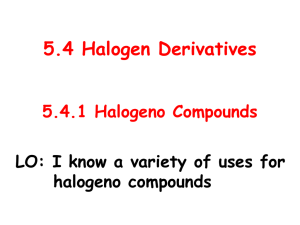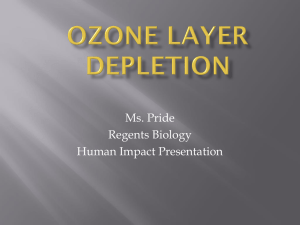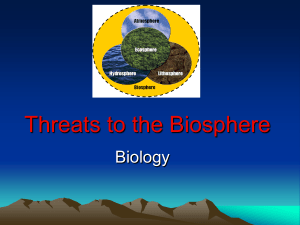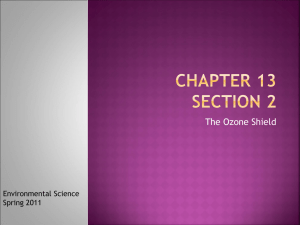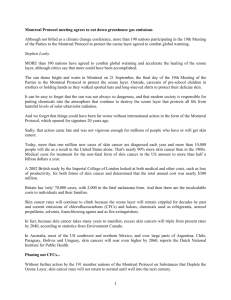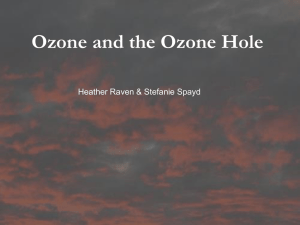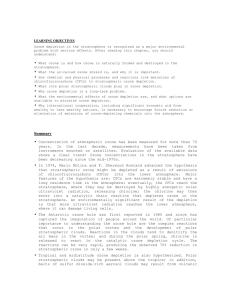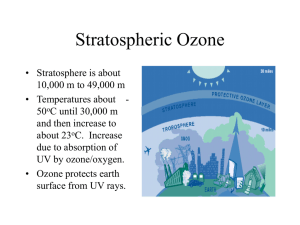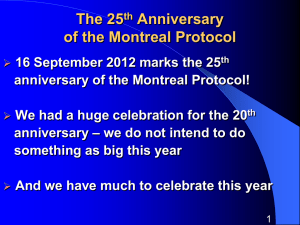International Environmental Regimes
advertisement
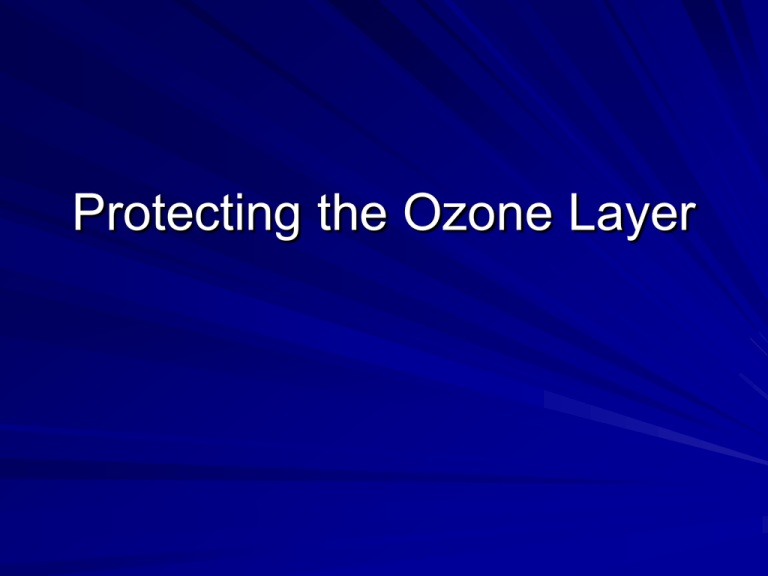
Protecting the Ozone Layer Stratospheric Ozone Depletion Ground-level (tropospheric) ozone: harmful pollutant Stratospheric ozone: shields the Earth surface from UV rays. Stratospheric Ozone Depletion F. Sherwood Rowland and Mario J Molina (1974) – – – – CFCs break down in the upper atmosphere Release chlorine Chlorine reacts with ozone, Ozone layer depletion Paul Crutzen (1970) – Nitrogen oxides –may deplete the ozone layer More UV radiation – skin cancer, cataracts, damage to other organisms, materials, crops Global Commons Problem Non-excludable: free access Subtractable: more CFCs less ozone layer Private costs of limiting CFC production and consumption exceed private benefits reducing ozone depletion; No central governing authority Scientific uncertainty International cooperation required But No Tragedy of the Commons? Why? Drama of the Commons The Ozone Layer Regime Act I Unilateral Action U.S. Regulations – In 1978 US unilaterally banned the use of CFC propellants in spray cans Canada, Norway, Sweden – Also restricted the use of CFC aerosols Act II Deadlock 1977-1985: complete deadlock , some symbolic actions Opponents to further regulation in US EC not interested to limit use in aerosols, suspects US of using science to advance commercial interests. Act III The Breakthrough The Vienna Convention on the Protection of the Ozone Layer (1985) -Encouraged research, cooperation among countries and exchange of information. -For the first time nations agreed in principle to tackle a global environmental problem before its effects were felt, or even scientifically proven. The Montreal Protocol (1987) – Production and consumption of 5 CFCs to 50% of 1986 levels by June 30; 1998. Freeze 3 Halons. Act IV Broaden Participation The 1990 London amendments – Complete ban on 15 CFCs, 3 halons, carbon tetrachloride by 2000, and methyl chloroform by 2005 – Multilateral Fund: funds the incremental costs incurred by developing countrie in ODS phasing out $240 million initial endowment fund to be spent over three years By 2001, 1.2bn contributed to the fund; 3500 projects in 124 countries. No ODS trade with countries, which are not parties to the treaty Developing countries: 10 year grace period for compliance. China, India and Brazil joined Act IV Tight International Regulations Amendments adopted at Copenhagen (1992), Vienna (1995), Montreal (1997) and Beijing (1999). Ninety-six (96) chemicals are presently controlled by the Montreal Protocol, including: – – – – – Chlorofluorocarbons (CFCs) and Halons. Carbon tetrachloride Methyl chloroform Hydrochlorofluorocarbons Methyl bromide Act V Tragedy of the Commons Averted? Effect of Ozone Regime? 1988 ozone hole 2000 ozone hole Tragedy of the Commons Reversed Caveats Imperfect compliance in Eastern Europe Illegal trade in CFCs – Supply: production still legal in some parts of the world; imperfect compliance by some former communist countries – Demand: older equipment (car AC, etc.). Discussion What explains the success of the Montreal Protocol? The Role of Science Placed the issue on policy agenda Consensual science – necessary for cooperation; – WMO/NASA Assessment (1986)-authoritative, peer reviewed assessment on stratospheric ozone: large losses if CFCs grow by about 3% – Ozone Trends Panel (1988): ozone hole; CFCs the main culprits – Depends on participation, sponsorship, procedures, outputs Implications Institutions should allow adaptation of rules -Even weak treaties can ratchet up Early targets important for innovation irrespective of stringency Feedback b/w regulation, technology, innovation, and domestic politics Repeated negotiations help ratcheting up Authoritative, consensual science essential Institutions can alter the cost and benefit structure of cooperation
